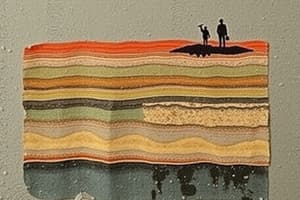Podcast
Questions and Answers
What property do magnets exhibit when facing like poles?
What property do magnets exhibit when facing like poles?
- They attract each other.
- They create a magnetic field together.
- They do not affect each other.
- They repel each other. (correct)
What type of force do magnets exert on each other?
What type of force do magnets exert on each other?
- Electromagnetic force
- Gravitational force
- Contact force
- Non-contact force (correct)
Which rod becomes negatively charged when rubbed with wool?
Which rod becomes negatively charged when rubbed with wool?
- Ebonite rod (correct)
- Copper rod
- Glass rod
- Wooden rod
What happens to the suspended glass rod when brought near a charged ebonite rod?
What happens to the suspended glass rod when brought near a charged ebonite rod?
What is the nature of electrostatic force?
What is the nature of electrostatic force?
When two charged bodies are brought close, what is the effect of like charges?
When two charged bodies are brought close, what is the effect of like charges?
What is an example of a non-contact force?
What is an example of a non-contact force?
What happens when an uncharged body is brought near a charged body?
What happens when an uncharged body is brought near a charged body?
What is the primary composition of the earth's core?
What is the primary composition of the earth's core?
Which layer of the Earth is found between the core and the crust?
Which layer of the Earth is found between the core and the crust?
What type of rocks primarily make up the earth's crust?
What type of rocks primarily make up the earth's crust?
What is the state of the outer core of the earth?
What is the state of the outer core of the earth?
Which type of plates are found under oceans?
Which type of plates are found under oceans?
What causes earthquakes to occur?
What causes earthquakes to occur?
How is the inner core of the Earth characterized?
How is the inner core of the Earth characterized?
What is the nature of the edges of the plates in the Earth's crust?
What is the nature of the edges of the plates in the Earth's crust?
What is the point on the earth's surface directly above the focus of an earthquake called?
What is the point on the earth's surface directly above the focus of an earthquake called?
An earthquake of magnitude 3 on the Richter Scale is how many times stronger than an earthquake of magnitude 1?
An earthquake of magnitude 3 on the Richter Scale is how many times stronger than an earthquake of magnitude 1?
Which magnitude on the Richter Scale is considered the minimum that can be felt by people?
Which magnitude on the Richter Scale is considered the minimum that can be felt by people?
What does an earthquake with a magnitude greater than 7 on the Richter Scale typically cause?
What does an earthquake with a magnitude greater than 7 on the Richter Scale typically cause?
How many times more destructive energy does a magnitude 6 earthquake have compared to a magnitude 4 earthquake?
How many times more destructive energy does a magnitude 6 earthquake have compared to a magnitude 4 earthquake?
What level of the Richter Scale is considered devastating?
What level of the Richter Scale is considered devastating?
What is a recommended precaution against earthquakes?
What is a recommended precaution against earthquakes?
Which earthquakes are categorized as really destructive?
Which earthquakes are categorized as really destructive?
What is the primary reason a ball rolling along the ground comes to a stop?
What is the primary reason a ball rolling along the ground comes to a stop?
Which type of force is friction classified as?
Which type of force is friction classified as?
What happens when a bicycle stops being pedalled?
What happens when a bicycle stops being pedalled?
Which of the following is an example of a non-contact force?
Which of the following is an example of a non-contact force?
What effect does gravitational force have on objects thrown upwards?
What effect does gravitational force have on objects thrown upwards?
Which statement is true regarding the direction of frictional force?
Which statement is true regarding the direction of frictional force?
Which force is responsible for causing ripe fruits to fall from trees?
Which force is responsible for causing ripe fruits to fall from trees?
How does a non-contact force differ from a contact force?
How does a non-contact force differ from a contact force?
What should be prioritized when constructing buildings in seismic zones?
What should be prioritized when constructing buildings in seismic zones?
Which material is preferable for construction in highly seismic areas?
Which material is preferable for construction in highly seismic areas?
What should be done with cupboards and shelves to ensure safety during an earthquake?
What should be done with cupboards and shelves to ensure safety during an earthquake?
If an earthquake occurs while you are in bed, what is the safest action to take?
If an earthquake occurs while you are in bed, what is the safest action to take?
What is a recommended practice for securing heavy objects in a home located in a seismic zone?
What is a recommended practice for securing heavy objects in a home located in a seismic zone?
What should individuals do to prepare for potential fires after an earthquake?
What should individuals do to prepare for potential fires after an earthquake?
What should be done with heavy objects during an earthquake to minimize risk?
What should be done with heavy objects during an earthquake to minimize risk?
How should individuals position themselves if they are near tall and heavy furniture during an earthquake?
How should individuals position themselves if they are near tall and heavy furniture during an earthquake?
Flashcards are hidden until you start studying
Study Notes
Forces in Physics
- Muscular force, applied through contact with an object, is categorized as a contact force.
- Frictional force causes a moving object, like a rolling ball or bicycle, to gradually slow down and eventually stop.
- Friction always acts in the opposite direction to the motion of the object.
- Non-contact forces can operate without direct physical contact between interacting bodies, exerting push or pull from a distance.
Types of Non-Contact Forces
-
Gravitational Force:
- Causes objects to fall towards Earth due to Earth's pull, known as the force of gravity.
- Acts without physical contact, classifying it as a non-contact force.
-
Magnetic Force:
- Magnets attract iron objects and exhibit attracting or repelling interactions between like and unlike poles, operating at a distance.
- Represents another example of a non-contact force.
-
Electrostatic Force:
- Occurs when charged bodies exert forces on each other without direct contact.
- Positive and negative charges attract, while like charges repel, showcasing non-contact interactions.
Structure of the Earth
-
The Earth consists of three main layers: Core, Mantle, and Crust.
-
Core:
- Innermost layer made primarily of iron, extremely hot.
- Divided into outer core (liquid molten iron) and inner core (solid due to high pressure).
-
Mantle:
- Central layer containing solid and molten rocks.
- Composed of dense materials, serving as the transition zone between core and crust.
-
Crust:
- Outermost layer characterized by lighter rocks.
- Thicker under continents and thinner beneath oceans, consisting of tectonic plates (continental and oceanic).
Earthquake Occurrence
-
Earthquakes occur due to the movement of tectonic plates along boundary interactions:
- Plates can slide past or collide with each other, creating seismic activity.
-
Epicenter is the point directly above the focus (the earthquake's source).
Measuring Earthquakes
- The Richter Scale quantifies earthquake magnitude from 1 to 12:
- Each whole number increase represents a tenfold increase in amplitude, with significant escalation in energy release.
- Earthquakes measuring above 7 on the Richter Scale are classified as destructive, and above 8.5 can be devastating.
Protection Against Earthquakes
-
Earthquake preparedness is crucial due to unpredictability:
- Buildings in seismic zones should be engineered to withstand earthquakes.
- Lighter materials (like mud and timber) are preferable for construction in high-risk areas.
-
Safety measures:
- Anchor cupboards to walls and place heavy items on lower shelves.
- Secure heavy objects to avoid falling during quakes.
-
Recommended actions during an earthquake:
- Seek shelter under sturdy furniture and protect your head.
- Stay clear of heavy furniture and glass windows.
- If in bed, remain still and protect your head with a pillow.
Studying That Suits You
Use AI to generate personalized quizzes and flashcards to suit your learning preferences.




